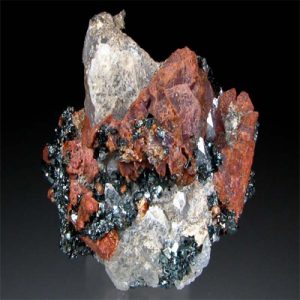Tephroite
Tephroite is a manganese silicate mineral that is a member of the Olivine Group of minerals that includes Fayalite,Forsterite, Olivine and Tephroite. Tephroite forms a series with Fayalite. Tephroite is the manganese rich member of the series and Fayalite is the iron rich member. Tephroite is a contact metamorphic and hydrothermal replacement mineral. It is commonly ash gray but also is found in colors of olive-green, greenish-blue, pink or brown. The type locality for Tephroite is the famous Sterling Mine, Sterling Hill, Ogdensburg, Franklin Mining District, Sussex County, New Jersey, USA. The Sterling Mine and nearby Franklin Mines are well known for their mineral abundance and diversity. In the area of the Franklin and Sterling Hill mines, 357 types of minerals are known to occur; these make up approximately 10% of the minerals known to science. Thirty-five of these minerals have not been found anywhere else. Ninety-one of the minerals are fluorescent. Tephroite is not a fluorescent mineral but is ofter found associated with fluorescent minerals such as Bustamite, Calcite, Willemite and Zincite. Tephroite was named in 1823 by Johann Friedrich August Breithaupt from Greek word tephros meaning ash-colored, alluding to the usual gray color of the mineral.
Locations for Tephroite: In the USA, from Franklin and Sterling Hill, Ogdensburg, Sussex County, New Jersey; at Bald Knob, near Sparta, Alleghany County, North Carolina; and in the Sunnyside mine, San Juan County, Colorado. From Buritirama, Piaui, Brazil. In the Harstigen mine, near Persberg; at Långban, Värmland; and in the Sjö mine, near Grythyttan, Örebro, Sweden. From the Benallt mine, near Rhiw, Lleyn Peninsula, Gwennyd, Wales. In the Meldon quarry, Okehampton, Devon, and the Treburland mine, Altarnun, Cornwall, England. At Val Malenco, Lombardy, Italy. From Bonneval-sur-Arc, Haute-Maurienne, Isère, France. Large crystals from the Wessels mine, near Kuruman, Cape Province, South Africa. In the Kaso mine, Totigi Prefecture, and the Noda-Tamagawa mine, Iwate Prefecture, Japan. From Broken Hill and Tamworth, New South Wales, Australia. On the Clark Peninsula, Wilkes Land, Antarctica.
| Chemical Formula: | Mn2+2SiO4 |
| Manganese Silicate | |
| Molecular Weight: | 201.96 gm |
| Composition: | Manganese | 54.41 % | Mn | 70.25 % | MnO |
| Silicon | 13.91 % | Si | 29.75 % | SiO2 | |
| Oxygen | 31.69 % | O | |||
| 100.00 % | 100.00 % | = TOTAL OXIDE |
| Crystallography: | Orthorhombic – Dipyramidal |
| Crystal Habit: | Crystals typically short, prismatic, to 4 cm, or anhedral, equidimensional. Commonly in disseminated grains, compact, or massive. |
| Twinning: | {011}, not common |
| Cleavage: | Distinct on {010}, imperfect on {001} |
| Fracture: | Uneven to conchoidal |
| Tenacity: | Brittle |
| Moh’s Hardness: | 6.0 |
| Density: | 3.87 – 4.12 (g/cm3) |
| Luminescence: | None. Often associated with fluorescent minerals such as Calcite and Willemite. |
| Radioactivity: | Not Radioactive |
| Color: | Olive-green, bluish green, gray, flesh-red, reddish brown; pale green in thin section, may be colorless. |
| Transparency: | Transparent to translucent |
| Luster: | Vitreous to greasy |
| Refractive Index: | 1.759 – 1.860 Biaxial ( – ) |
| Birefringence: | 0.101 |
| Dispersion: | r > v |
| Pleochroism: | None or weak; X = brownish red; Y = reddish; Z = greenish blue |


